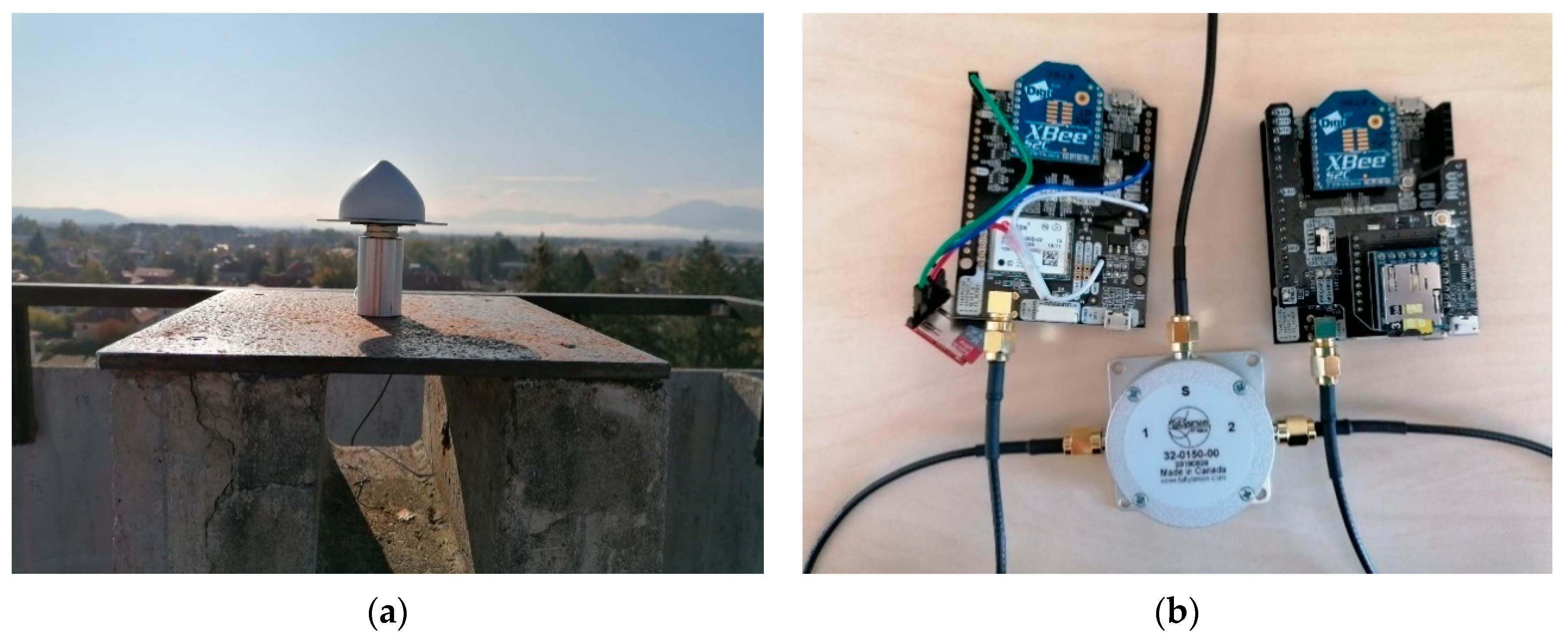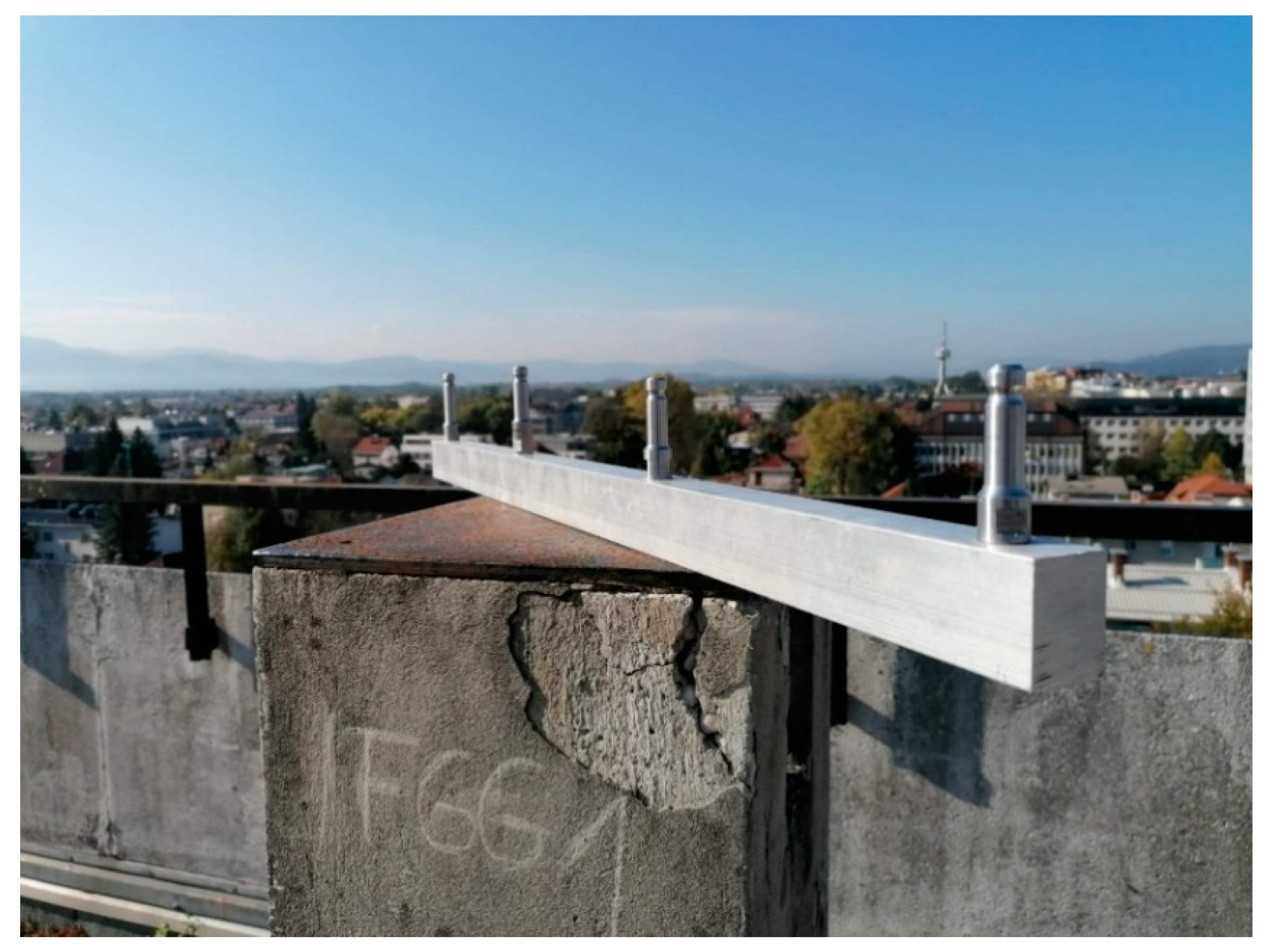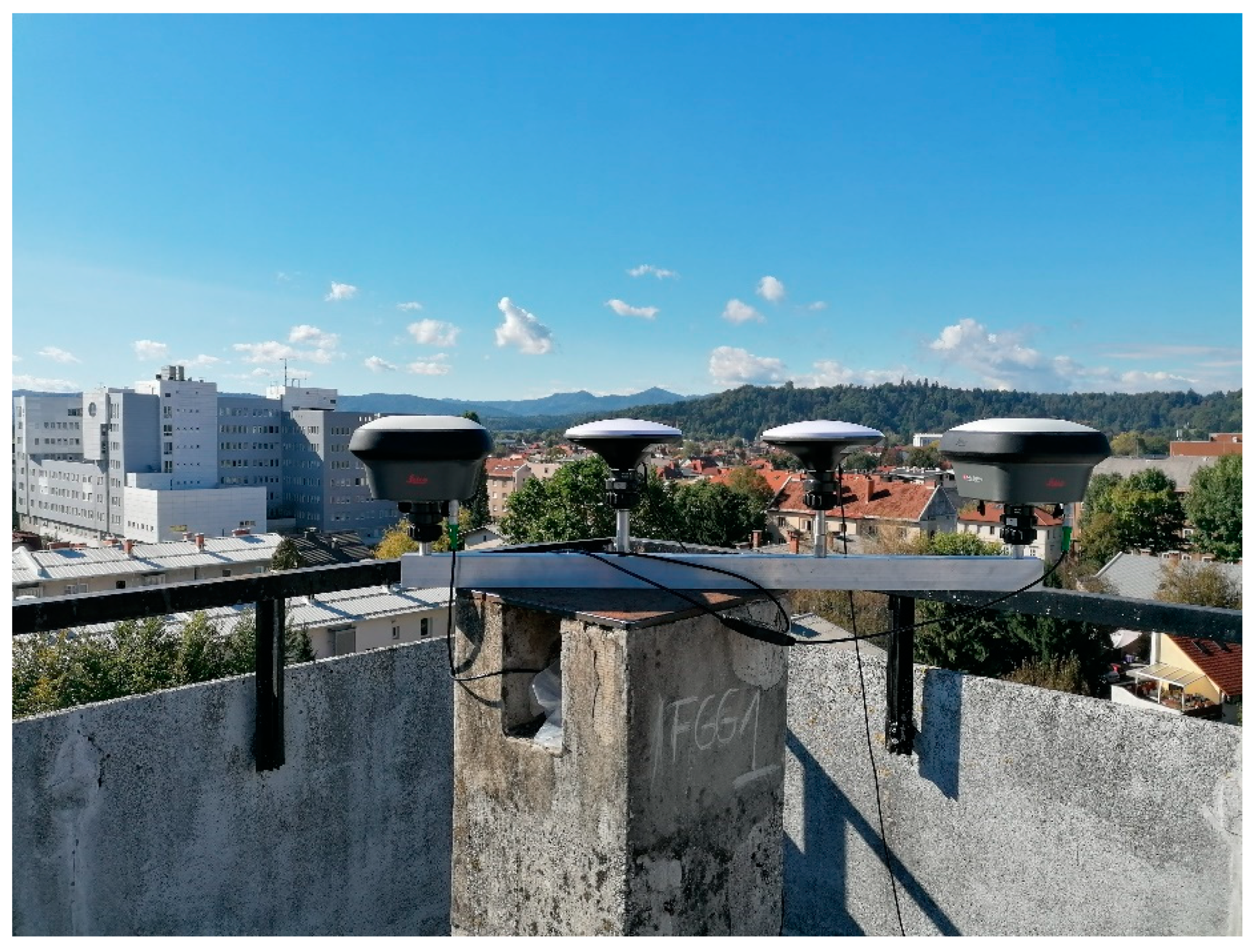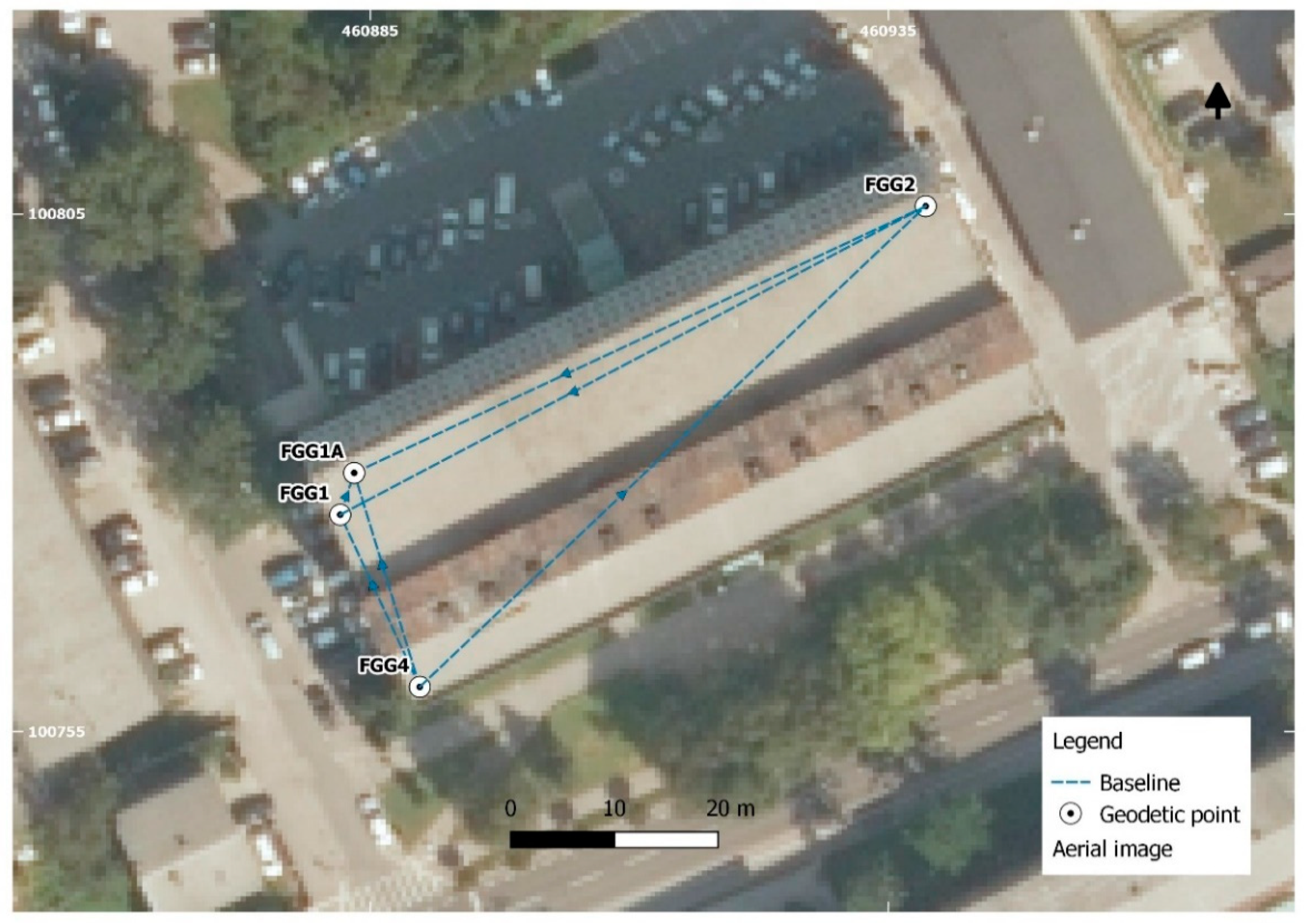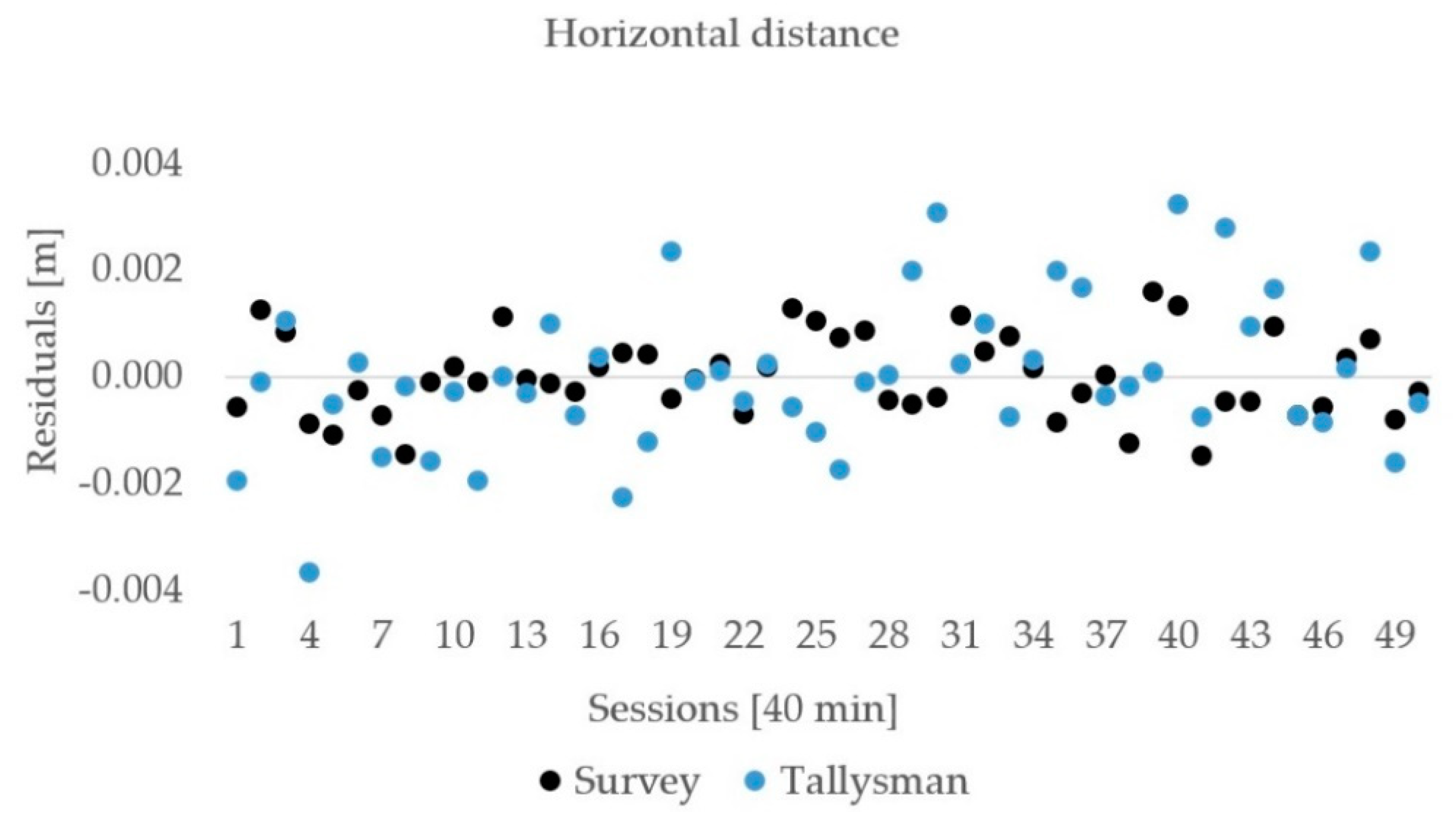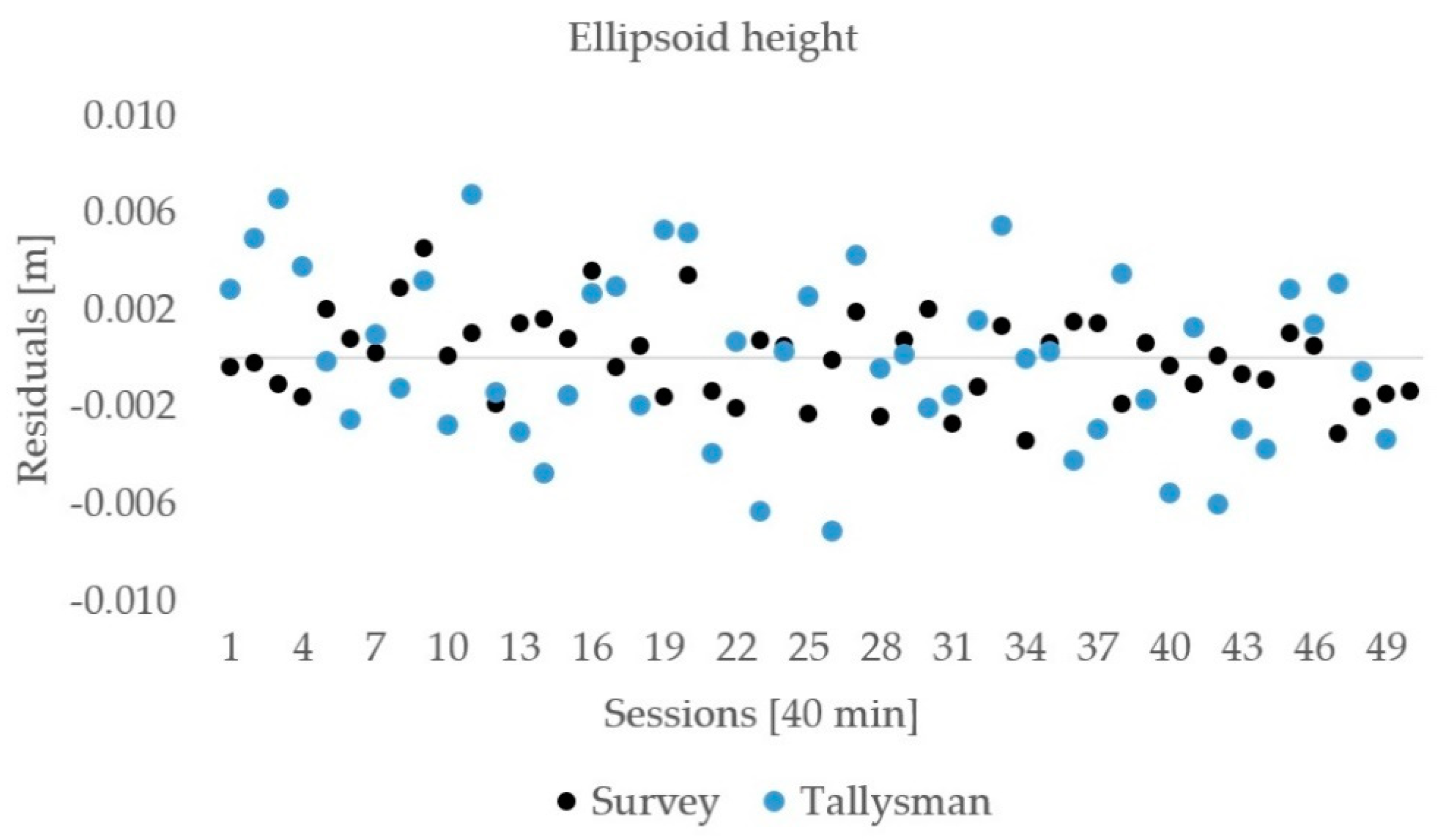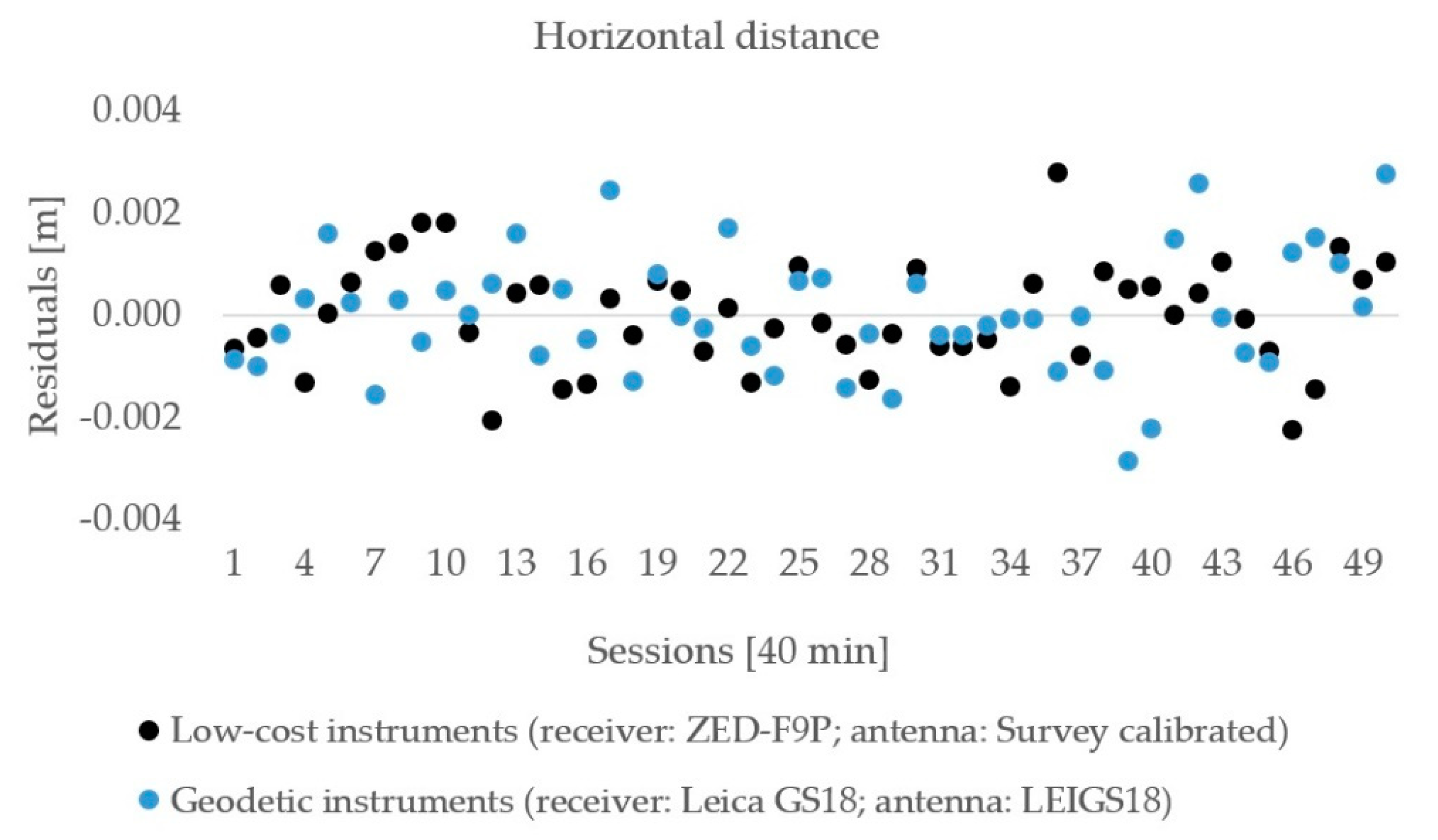Global Navigation Satellite System (GNSS) is a widely used technology for different positioning and navigation purposes. When the highest possible accuracy is required, then geodetic GNSS instruments are typically used in various applications [
1,
2,
3,
4,
5]. The positioning quality obtained on the basis of geodetic GNSS instruments is dependent on their quality; however, to obtain the highest quality results, many errors must be accounted for. Positioning quality on the level of a few millimeters requires the biases to be strictly dealt with—they must be either modeled, mitigated, eliminated, or estimated within the least-squares process [
6,
7,
8]. The increase in the positional quality was achieved with the development of GNSS instruments, modeling biases, processing algorithms, and also with the advent of multi-GNSS [
9,
10].
1.1. Overview
Low-cost GNSS receivers have been analyzed and tested in various applications [
16,
19,
20,
21,
22,
23]. Tests were typically carried out over short baselines and in favorable surveying conditions, i.e., in an open-sky environment [
12,
17,
24]. However, in cases where their performance was tested in challenging conditions and over long baselines, the results showed a decrease in quality but were still acceptable considering their costs [
15,
22]. The combination of low-cost GNSS receivers with geodetic antennas has been shown to improve their performance [
16].
To test the performance of GNSS receivers, only the zero baseline test or short baseline test is usually applied [
25,
26,
27,
28,
29]. Within the zero baseline, all external errors are eliminated with the construction of double differences, and therefore only the receiver error remains. A study by Roberts et al. [
26] analyzed the accuracy of Global Positioning System (GPS)-only, BeiDou (BDS)-only, and a combination of GPS/BDS within zero baseline, where geodetic instruments were used. The results on a basis of GPS showed better performance compared to BDS; however, the latter has not yet been fully operational.
A detailed study of code and phase observation noise for two types of geodetic receivers was performed by Zhang et al. [
29]. The results showed comparable quality of the code observations, whereas, in the case of phase observations, significant differences in the quality between different receivers were obtained [
29]. A study by Amiri-Simkooei and Tiberius [
28] reported that the receiver noise was slightly different for several receivers from the same manufacturer. The evaluation was done with the zero baseline test and also with a short baseline test, where for the latter, harmonic functions were used to compensate for the multipath error. In the case of Dróżdż and Szpunar [
30], the noise of observations was determined with a signal simulator, and the results indicated that the quality of observations may vary among different receiver types. The study by Han et al. [
31] used an signal-to-noise-dependent environmental model, where observation weights are determined based on the satellite elevation angle in order to reduce the noise in harsh environments. The noise of GPS/GLONASS or GPS/BDS was lower than the noise of GPS-only, and the combination of measurements from more constellations was shown to improve the quality of the obtained coordinates [
32].
Geodetic GNSS instruments were used as a reference to test low-cost instruments in dynamic and static scenarios, and the results indicated that, in certain applications, low-cost instruments can have satisfactory performance that is comparable with geodetic instruments [
18,
19]. Geodetic as well as single-frequency low-cost GNSS receivers were tested in Real-Time Kinematic (RTK) mode following the International Organization for Standardization (ISO) standard 17123-8. The uncertainties for the geodetic instruments were 2.5 and 4.5 mm for the horizontal and vertical components, respectively, whereas, in the case of low-cost instruments, the uncertainties were 5.5 and 11 mm for the horizontal and vertical components, respectively. However, over short baselines, low-cost instruments were comparable to the geodetic GNSS instruments [
12]. In the case of Lambrou and Kanellopoulos [
33], GNSS instruments were tested in virtual reference station-RTK positioning mode, where the accuracy and precision of the GNSS instruments were analyzed. The study by Sioulis et al. [
17] tested u-blox NEO-7P receivers in RTK mode, where the results met the requirements defined in Class 2 of the ISO RTK testing procedure. A single-frequency EVK-M8T receiver in combination with a survey-grade antenna was tested in RTK mode with short baselines. The results indicated that the low-cost receivers achieved comparable performance with the high-ended geodetic GNSS instruments [
34]. Ambiguity resolution and positioning performance in the RTK mode for the EVK-M8T receiver were compared with dual-frequency GPS geodetic receivers. The results showed that there was competitive performance with the geodetic GNSS receivers, even though small ionospheric delays were present [
35]. The study by Odolinski and Teunissen [
36] emphasized that single-frequency u-blox EVK-M8T receivers (L1 + B1) with patch antennas reached similar ambiguity resolution performance in RTK as double frequency geodetic receivers (L1 + L2 GPS).
Low-cost u-blox LEA 4T receivers were evaluated in a controlled error-free environment in static as well as dynamic scenarios [
25]. They showed that the level of multipath was much smaller in a static scenario; however, in the case of a dynamic scenario, the multipath may severely degrade the performance. U-blox LEA-6T and NEO-7P receivers were tested with geodetic antennas over short and long baselines in static mode by following the guidelines that consisted of the ISO standards. Both receivers showed low receiver noise and baseline vectors, and the coordinates were determined with accuracy comparable to the geodetic receivers with short baselines. In long baselines, the low-cost receivers showed worse results, but were still satisfactory [
18]. The study by Guo et al. [
11] reported that low-cost single-frequency receivers provided low noise in open sky conditions, and their performance was comparable with geodetic receivers over short baselines.
Recently, multi-frequency low-cost GNSS receivers were released on the market that can track signals in both L1 and L2 frequencies from all available constellations. Nie et al. [
37] proposed a new method where single-frequency ionosphere-corrected code observations, dual-frequency ionospheric-free code and phase observations, and precise ionospheric products are combined in one model for dual-frequency low-cost (ZED-F9P) receivers. The results indicated that the proposed method reached a faster horizontal accuracy of half a meter in real-time precise point positioning. Dual-frequency receiver (ZED-F9P) in combination with a u-blox ANN-MB patch antenna was tested in short and long-baseline in RTK mode. In long baselines, it had worse performance compared to the geodetic GNSS instruments [
38]. Multi-frequency low-cost GNSS receivers were also evaluated in combination with geodetic as well as low-cost antennas [
14,
19,
20,
39]. Lastly, calibrated low-cost antennas are available in the market, which makes multi-frequency low-cost receivers even more comparable with geodetic GNSS instruments.
1.2. Work Organization
In this study, we evaluated the performance of a multi-frequency low-cost receiver, namely, ZED-F9P, in combination with different types of low-cost antennas. The main objectives were to analyze the noise of the receiver, to evaluate its positioning performance with different types of low-cost calibrated and non-calibrated antennas, and to compare the quality of the coordinates obtained from geodetic and low-cost GNSS instruments.
First, the procedure of testing the GNSS receiver positional quality is described, with a special focus on the performance of the low-cost receivers (
Section 1). The implemented zero baseline test, short baseline test with different types of low-cost antennas, and the comparison of coordinates obtained from low-cost and geodetic GNSS instruments are shown in
Section 2. The results are presented and discussed in
Section 3. In the end, the conclusions are listed (
Section 4).
